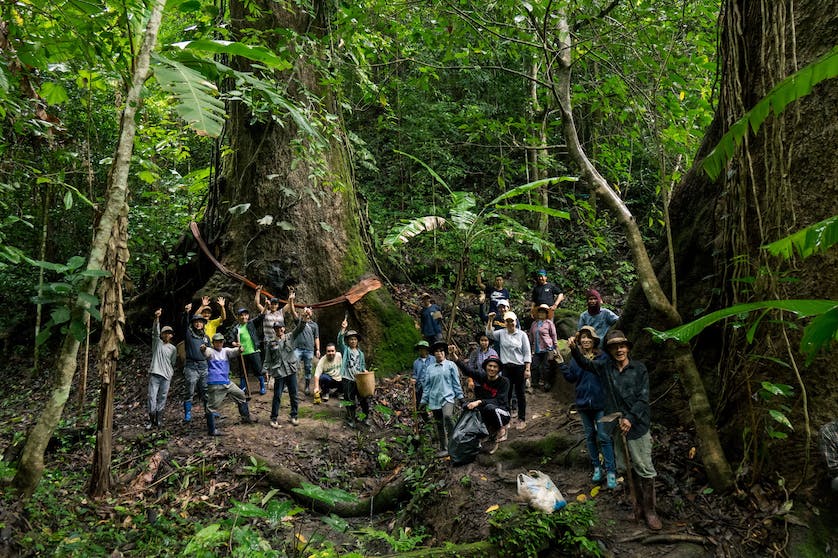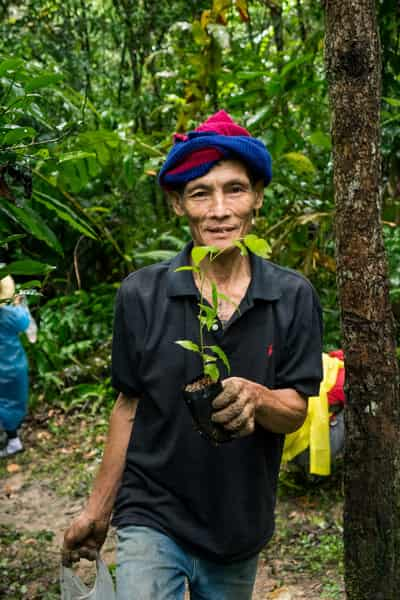Rain pattered gently on surrounding foliage, a cool breeze rippling quietly through the dense forested greenery. A small stream trickled over smooth stones, meandering slowly through the undergrowth. The sound of birds chirping emanated peacefully from somewhere above. The soft noises bounced around lightly, touching the leaves and stirring small dew droplets.

I stood on a rough muddy track, a bag of small trees in hand. My drenched hair flopped down into my eyes, a few water droplets inching down my forehead. One of the volunteers enthusiastically beckoned me over to the side of the trail. I walked over quickly, setting down my bag of saplings. He crouched down and removed plastic wrapped around one of the small tree’s roots. Setting the tree in an earthen hole, he then packed the mud around it carefully. When the volunteer was done, he stood up satisfied, silently admiring his handiwork. I spent the rest of the morning on the rutted and gnarled forested path, joining forces with a plethora of volunteers, as the rain consistently came down from above.
A large tree planting conservation project recently took place in the small town of Mae Kampong. This project involved planting trees in the rainforest, which helps to increase the density of the foliage, and preserve the natural beauty of the surrounding area. The event was organised by Flight of the Gibbon, a company that does zip line tours as well as other conservation and community development. For this particular project, Tree Planting in Baan Mae Kampong, the Flight of the Gibbon employees worked alongside local villagers. “We coordinate with local people and local government,” explains Thara, the Digital Marketing Manager for Flight of the Gibbon. But it wasn’t just the Baan Mae Kampong locals that helped out at the event. The Kaew Subdistrict Administrative Organisation staff and Teentok Royal Project staff also volunteered, planting a grand total of 1,000 trees. 100 people participated at Tree Planting in Baan Mae Kampong, which took up most of a morning.
The tree planting took place at a nature trail in the rainforest, just outside of Mae Kampong. This winding path is quite beautiful, surrounded by large trees and crossed by a quiet babbling brook, gurgling quietly over smooth stones. “In the past people used this path to go harvest coffee beans. They also used the trail to find stuff to eat, like herbs,” says Thara. Nowadays, though, the path is used mainly for hiking and recreation. In recent years, Mae Kampong has become much more well known, and a popular destination for tourists. As a result, the trail has increased in popularity among visitors. “There are more tourists coming to Mae Kampong. The village came up with the idea to take them to this path, to study nature and the history of the village,” explains Thara.

The conservation project in Baan Mae Kampong is just one part of a larger and more ambitious long-term goal. This event is merely one piece of the puzzle in a much bigger picture. “We want to plant one million trees in 20 years,” says Thara. In order to achieve this goal, there have been a number of conservation projects over the years, the first one occurring in 2007. Flight of the Gibbon organises at least one conservation project each year. Each individual project has its own size and impact, some larger than others. For example, in 2014, they planted 5,000 native saplings in Mae Kampong. Another project in Lampang planted 11,000 saplings in Tham Pha Thai National Park. The majority of tree planting projects occur in Mae Kampong and Mae On as well as in other parts of Thailand. “Last year we coordinated with the Thai Navy Seals to plant mangroves in Sattahip in Southern Thailand,” says Thara, on a recent project.
The company has also sponsored fire breaks in Mae Kampong, offered free zip line rides to underprivileged kids, sponsored a local marathon, cleaned up Mae Kampong, rehabilitated gibbons and donated funds to restore a local temple. Through their numerous tree planting projects and other charitable work, Flight of the Gibbon hopes to continue to positively impact the environment, one sapling at a time.
